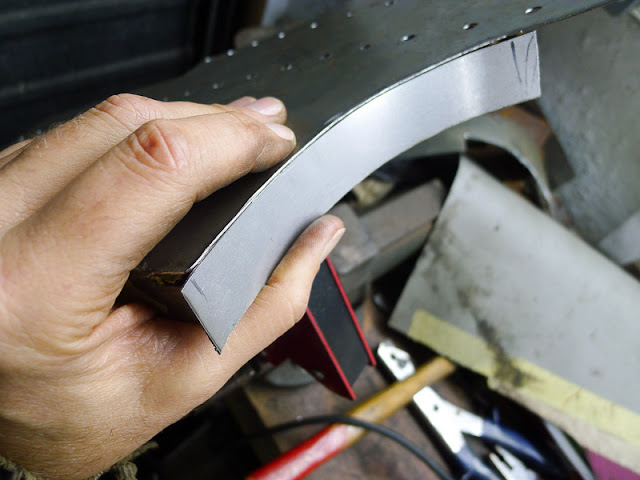Picking up from where we left off, I had decided that I needed to create a controlled curve in the panel that I was creating for the front part of the O/S boot floor. I felt I needed a slip roller, or something similar. Researching available tools it soon became apparent that cost was disproportionate, given that it was entirely possible that I would never need this tool again, and so a 'DIY' solution was required. A couple of hours on YouTube and a root through the scarp metal bin... I came up with a plan.
I used a couple of scrap bearings salvaged from Mazda Bongo idler pullys, two Ikea desk legs and an old HiFi speaker stand. The bearings fitted perfectly into the ends of the desk legs, great, so I then fitted some bolts and washers through the centre go the bearings as spindles. On the other end of the legs I found a couple more bolts that fitted snuggly into the plastic feet. Obviously not a robust solution, but I figured strong enough to last the short time required.
I then created two end brackets. I took the top of the old speaker stand and cut it in half. I flipped one half over, then bolted the two together using existing holes. Next I measured and drill two holes through the two plates, representing the thickness of the rollers plus 2mm to allow for the thickness of the steel to be rolled.
I then cut two pieces from scrap bar and welded them at 90º to complete the end brackets. The hole apparatus was the assembled by drilling and bolting to the bench.
Now of course this isn't a proper slip roller (there are only two rollers for a start) but what I found I was able to do was effect a controlled bend by rolling the piece backwards and forwards through the rollers, whilst applying upward pressure. Sounds somewhat rudimentary, because it is, but hey... it worked.
The panel itself had been cut flat using a card template and now that the curve was added, it was a excellent fit. Using the remnants of the original floor panels (which were still hanging on by a whisker) I marked out the fold for the longitudinal lip, then folded in using my DIY metal brake. I also marked and punched holes for the plug welds.
Finally, I cut strips to form the lip to the inner wheel tub and welded them in position, on the bench.
And here is the finished repair panel.
I have now welded this to the floor and chasis rails and it look pretty neat. It also feels really strong which of course is the most important thing. On to the next panel...
< previous post next post >










Comments
Post a Comment